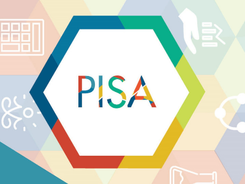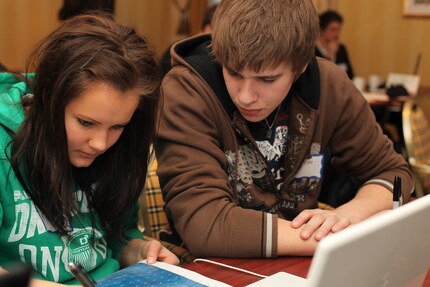|
12/15/2019  I was present recently when a high school teacher colleague, Lauren, did a “hands-on” lesson about the greenhouse effect with her Ecology class. The manipulatives students were using, tokens, were intended to represent units of energy transmitted to earth. Lauren discussed the movement of energy during different steps of the greenhouse effect and students needed to listen and move the tokens to appropriate diagrams that depicted the step that was being described. Lauren confided to me that she planned to teach a similar activity during her upcoming observation by her supervisor.  When she told me, I agreed with the idea of using a “hands-on” activity for an administrative observation. It’s good that she knows to tailor her “teaching performance” for an administrator whose job it is to espouse the current edutrend of hands-on instruction. She’s smart enough to realize that it’s unimportant whether a dinosaur teacher such as myself agrees with her teaching methods. I don’t. Although Lauren is a capable teacher, I wasn’t particularly impressed with the lesson. I could see that most students weren’t participating and I doubted even those that were moving the tokens as Lauren instructed were really listening and thinking about the greenhouse effect. The fact that each of the students was not responsible for producing some evidence of their having engaged with the lesson topic showed a disconnect between her teaching and their learning.  Lauren, a young, untenured teacher, is giving the administrators in my district what they want to see. She is very conversational with her students and makes social connections with them outside of instructional time. Her class presentations are nondirective and she frequently checks in with students by asking how they feel and what they want out of class. She asks them to produce very little written or tangible work and accepts whatever they give, no matter the quality. Her “lessons” which require the students to actually do anything amount to moving objects from one area to another, blowing into jars, coloring, or drawing.  Although a “hands on” style of teaching has been used for some lessons by teachers for nearly eighty years, the method has become more in vogue in the last three decades. School administrators often recommend its use with students who are euphemistically termed as having “diverse learning styles”. Academically stronger students are grouped with their struggling counterparts in “cooperative groups” to “construct knowledge” together. These heterogeneous groupings include learners who struggle with attentiveness, reading, writing, listening, and other basic skills. In recent years it also includes immigrant students who have limited understanding of the english language.  Having been in the classroom for several decades working with students in college, general K-12 education, and special education, I have had the opportunity to both observe and instruct students in directed, guided, and discovery learning. You can’t be a professional in the field of education without also having been exposed to these differing delivery styles as an adult, perhaps as well as in childhood. I certainly remember working on projects, labs, and other independent learning activities throughout my early education in the 1970s and 1980s, after teachers gave directed instruction and made sure that students had a basic grasp of the topic and requisite skills.  But now teachers are urged to use non-directed learning with struggling students. Couple this with the social promotion of students to progressive grade levels without mastery, the addition of students who would be better served in a class solely focused on english language acquisition, and the general societal breakdown of civility, and bedlam ensues. Good luck with classroom management.  This non-directed learning and social promotion stems from a progressive philosophy in education has been steadily advancing since the 1960s. Direct instruction, common until the 1950s, was viewed by progressives as being too authoritarian. Instead, a “child-centered” approach was promoted which is touted as “active” and, therefore, superior. Using the hands-on philosophy, pupils are encouraged to ‘discover’ knowledge by themselves, often working in small groups, with the teacher offering them guidance. A predictable by-product of small groups of students working without teacher direction is that children will chat with friends and otherwise use time and resources inefficiently. Novice and developing learners are simply not self-directed and will not make purposeful steps toward learning. Class time will be squandered. We can see evidence of this in US student performance on international ranking exams.  The United States ranks below the top twenty countries on international measures of academic skills (PISA, TIMSS, and PIRLS). Examination of what higher ranking countries do in the classroom that is different than in the US is revealing. Countries with high pupil educational attainment have teachers who ask a large number of questions and check the responses of all students. Teaching practices commonly employed but not supported by evidence include using praise lavishly and allowing learners to discover key ideas by themselves. (https://www.suttontrust.com/research-paper/great-teaching/ )  Although it’s true that the educational systems are centrally controlled in several countries at the top of the PISA, TIMSS, and PIRLS lists, that is not true for all. Finland has national curriculum guidelines and schooling in Canada is controlled by each province. Finland ranked five and Canada came in at seven on the 2015 PISA rankings. As it turns out, memorization and rote learning are important classroom strategies. Some things, such as times tables and vocabulary words must be memorized until they can be recalled automatically.  Another edutrend is catering to children's "unique learning styles". (This is the claim that children learn best either by listening, watching, being physically active, with their hands, or reading.) On the contrary, UK researchers (https://www.suttontrust.com/research/ ) have found that there is no psychological evidence that there is an increase in student learning from presenting information to learners in their preferred "learning style". Instead of taking the time, energy and resources to customize what is being taught to the supposed individual learning styles of every child, it is more effective to employ more explicit teaching strategies and to spend additional time monitoring and remediating as necessary Another edutrend is undeserved praise or reward. Some schools use the "positive referral" to say "good job!" for things like getting to school on time or staying on task in class. Showering students with false praise is counterproductive. It lowers the bar and reinforces the idea that close is good enough. This is especially damaging for low performing students. It is a mistaken belief that harm will come to a child's psyche if he/she is told they must improve.  My purpose with this post is not to say that all hands-on activities are bad. Teachers employ various strategies in their classrooms. Memorization is necessary for novice learners so that information can be recalled easily and automatically. But education is also about curiosity and creativity. When students are exploring a topic that interests them, they can research and analyze, further developing their independence as a learner. Those are times when rote learning is unsuitable. Factors such as the topic to be taught, the order of the topic in the planned curricular sequence, the type of student (novice, developing, expert), and other variables determine how teachers must adapt their teaching to the situation. This should remain the purview of the teacher without ivory tower academicians and administrators muddying the waters with questionable philosophies and bogus directives.
0 Comments
Leave a Reply. |
AuthorGertrude Katz has spent over 30 years teaching K-12 public school students all major subjects. She has taught biology and education at the college level. The majority of her career has been spent instructing biology at the secondary level. Categories
All
|
 RSS Feed
RSS Feed